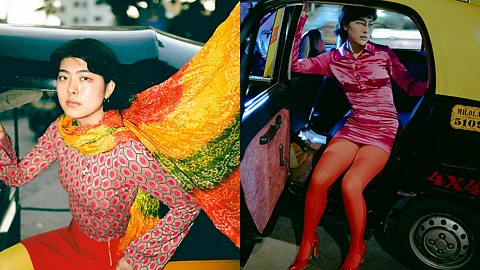
- HOMEGROWN WORLD
- #HGCREATORS
- #HGEXPLORE
- #HGVOICES
- #HGSHOP
- CAREERS
- ABOUT US
- CONTACT US

Mumbai is always moving. Mumbai Monogatari, a street fashion editorial conceptualised by art director Karan Mehta and shot by photographer Anurupa Praharaj, mirrors the kinetic energy of the maximum city. Shot entirely in transit — in taxis, rickshaws, sidewalks, and market corners — this editorial moves with the unstoppable momentum of Mumbai without trying to tame it. Here, the subject (Japanese-Native American model Cera Gigi) does not perform for the city. She exists — poised, aware, and still, but not overly stylised — as the world moves around her.
This is a deliberate departure from the dominant visual tropes in contemporary Indian fashion photography. Over the last decade, a parallel visual economy has taken hold of India's fashion imagination — often split between high-gloss maximalism, featuring gilded saris and soft-focus palaces, and posturing minimalism that flattens urban space into sterile aesthetic zones devoid of character. Mumbai Monogatari is a rejection of both. The editorial draws its strength from stillness amidst the chaos of a Mumbai street in motion.
The editorial draws inspiration from the slow-burn intimacy of Wong Kar Wai's films and the hushed detachment of Sofia Coppola's Lost in Translation (2003). However, while those worlds linger between yearning and dislocation, Mumbai Monogatari exists squarely in the present moment. Guided by photographer Anurupa Praharaj, the lens maintains an unflinching softness, offering a cinematic gaze that is empathetic to the chaos of the city. In her hands, the noise of Mumbai transforms into a kind of music, while its stillness — so rarely seen and heard — becomes something sacred.
Mumbai Monogatari stands out in its refusal to to overstyle or oversell the myth of Mumbai. It's not a glossy portrait of Mumbai, nor is it a romantic one. It doesn't attempt to tell a story in the traditional sense. There's no narrative arc, no promise of a climactic release. Rather, what ties it together is a sensibility: a way of being in the city without rushing through it.
If you enjoyed reading this, here's more from Homegrown:
Photographs As Relics Of Feelings: The Ethereal Image-Making Practice Of Vijay Sarathy
Jahnavi Sharma's Zine Centres Women's 'Drawers' As A Site Of Intimacy & Ritual
‘Snoops On A Train’ Captures the Unintentional Intimacy Of Mumbai Public Transit
